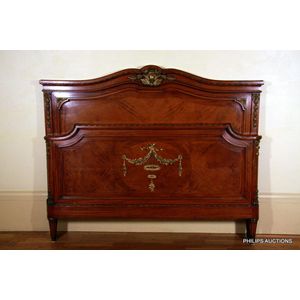19th Century Mahogany Cabinet with Renaissance Ormolu Handles
You must be a subscriber, and be logged in to view price and dealer details.
Subscribe Now to view actual auction price for this item
When you subscribe, you have the option of setting the currency in which to display prices to $Au, $US, $NZ or Stg.
- Pediment - The uppermost section of a tall usually double-heightened piece of cabinet furniture, surmounting the cornice. The pediment can take a variety of forms derived from the architecture of classical antiquity. A broken pediment is of triangular shape, however, the two raised sides do not meet at the apex but are 'broken' the gap between them often ornamented with an urn or finial. Swan-neck pediments are of similar form, although the uprights are gracefully arched, resembling a swan's neck. They are often found, for example, on longcase clocks.
- Mahogany - Mahogany is a dense, close grained red-coloured timber from the West Indies and Central America. It was first imported into Europe in the the early 18th century and its use continued through the 19th century. It was popular for furniture making because of its strength, the wide boards available, the distinctive grain on some boards, termed flame mahogany and the rich warm colour of the timber when it was polished.. The "flame" was produced where a limb grew out from the trunk of the tree, and this timber was usually sliced into veneers for feature panels on doors, backs and cornices.
Some terms used to describe mahogany relate to the country from which it originally came, such as "Cuban" mahogany, "Honduras" mahogany etc. However unless the wood has been tested the names assigned are more a selling feature, rather than a true indication of the timber's origin. - Ormolu - Ormolu was popular with French craftsmen in the 18th and 19th century for ornamental fittings for furniture, clocks and other decorative items. True ormolu is gilt bronze, that is bronze that has been coated with gold using a mercury amalgam. Due to the health risks associated with using mercury, this method of creating ormolu was discontinued in France in the 1830s. A substitute was developed consisting of about 75% copper and 25% zinc, however it was inferior to the bronze version. It was often lacquered to prevent it tarnishing.
This item has been included into following indexes:
- cabinets, material - ormolu and bronze mounted 224
-
cabinets, period or style
- Continental 24
- Dutch 30
Visually similar items

A French mahogany & ormolu bed with neoclassical Elements, late 19th century, the bedhead of gently arching form with quarter veneer panelling and applied moulding, an applied ormolu motif to the crest, small spandrels and pendants, the bed end of conformi

A Louis XV walnut commode rectangular, with three serpentine fronted drawers with carved panels and foliate cast metal handles, cabriole supports, 116 x 90 x 54 cm

A Dutch provincial oak three drawer marble top commode with bronze handles. 98 cm high, 136 cm wide, 60 cm deep.

A Louis XVI style satinwood gilt metal mounted cabinet with marble top above cupboards and lower shelf; 161 cm high, 80 cm wide, 43 cm deep
